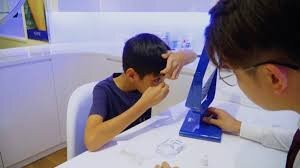WHAT IS MYOPIA MANAGEMENT?
Myopia MANAGEMENT Methods
There are four widely-accepted methods of treatment in myopia management. One can consider low-dose atropine, soft multifocal contact lenses and orthokeratology as all quite similar in terms of their myopia management efficacy, being around 50% on average. This effectively means that your child will likely still progress under any of these treatments but progression will likely be at half the rate of an average, similarly aged child in a single vision spectacles. The last option of peripheral defocus spectacles/Progressive addition lenses has efficacy of around 33% but new designs are coming soon to improve on the first generation designs.
Combination therapy has been also used in clinical practice on patients exhibiting a strong risk of myopic progression. More studies are ongoing and will be released to determine the benefits of combining two or more types of treatment.
ORTHOKERATOLOGY
These special contact lenses are designed to reshape/mold the cornea overnight to temporarily reduce the corneal power and myopia once they are removed. Ortho-K lenses are only worn overnight and removed in the morning, providing freedom from corrective lenses in the daytime. In theory, the lens design produces peripheral hyperopic defocus in the retina, resulting in less stimulus for elongation of the eye. It is the most popular method of myopia control treatment for school-aged children .
LOW-DOSE ATROPINE DROPS
These drops, instilled once nightly, are used to dilate (open) the pupils and fully relax the focusing power (accommodation) of the eye. Studies have shown its effectiveness in a concentration-dependent response. While varying strengths (1%, 0.5%, 0.1%, 0.05%, 0.025%, and 0.01%) of atropine eye drops all reduced myopic progression, patients/parents must be made aware of the off-label use of these drugs, as well as all possible side effects, such as light sensitivity and impaired near focus (accommodation) and a rebound effect of increased myopia after cessation of treatment, all of which are heightened with higher concentrations. The eyedrops must be made at specialized compounding pharmacies and the exact mechanism of myopia management through atropine is still yet to be determined (unlike the other methods of treatment)
PERIPHERAL DEFOCUS SOFT CONTACT LENSES
This treatment option included early use off-label of multifocal disposable contact lenses that were originally designed for adults with near vision blur. Most recently, Coopervision’s ‘MiSight’ was a daily disposable soft contact lens specifically designed and studied in children for myopia management. These dual-focus, multifocal contact lenses work by presenting the peripheral retina with hyperopic defocus, thus reducing the drive for axial elongation, and reduce myopia by about 50% compared with controls wearing single-focus contact lenses. This outcome is similar to that of orthokeratology and is required to be worn 6 days a week, on average 10 hrs a day to be effective.
PERIPHERAL DEFOCUS SPECTACLE DESIGNS
If your child is not a candidate for contact lenses or low-dose atropine, specialized designs in spectacles can be a useful treatment option. Previously, progressive addition (invisible multifocal) or line bifocal spectacles were shown to be clinically useful effects of around 33% efficacy on average (less than other options but still effective).
However, new spectacle lens technology for myopia control has now arrived in Canada in 2020 – the award winning Defocus Incorporated Multiple Segments (DIMS) spectacle lens, developed at Hong Kong Polytechnic University is now available. The DIMS lens looks like a single vision lens but could work more like a contact lens because of its innovative design, and has shown contact-lens-level results of 50% refractive control and 60% axial length control in the newly published two year study.
WHAT IS THE BEST TREATMENT OPTION FOR MY CHILD?
A comprehensive eye examination is the first step in any myopia management discussion. Dr. Koh will assess the risk factors unique to your child and develop a comprehensive plan and the best treatment method(s) to slow down myopia before it takes hold. Dr. Ivy Koh at Specs & Spines Optometry is passionate about myopia control and it’s latest research. For more information, please contact our clinic today.
WHAT ABOUT PROGRESSIVE MYOPIA IN ADULTS?
While previous research on myopia management has generally shown evidence of stabilization of myopia around age of 15 yrs, it is more common in clinical practice to note adult patients in their 20s and 30s that still show myopic progression. Continued lifestyle changes and increased visual demands on can have a definitive role on progression - examples include: patients with professional degrees or new occupations that require increased hours on digital devices.
While it can be inferred that myopia management treatments used in children can provide similar results in adult patients, visual demands are more challenging and varied which can limit the expectations for the patient. Studies are ongoing to find out more about the effectiveness of myopia management techniques on adults and hope to be shared soon with clinicians.





